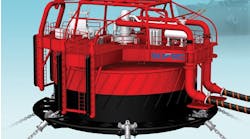IHS Kingdom 2015 software advances integration of geology, geophysics
IHS Inc. has launched IHS Kingdom 2015, the latest release of its geoscience software. It offers integration advances such as dynamic map updates, geosteering, and 3D geology and fault attributes based on patent-pending technology, further enabling geologists, geophysicists, and engineers to work in a shared platform for greater efficiency.
IHS Kingdom 2015 is a Microsoft Windows-based geoscience software interpretation tool.
"IHS Kingdom 2015 is a major step forward for the industry in terms of workflow integration, efficiency, and accuracy," said Clifford Kelley, IHS geoscience portfolio lead at IHS Energy. "The application provides new, best-of-breed functionality for geoscience interpretation that spans geological, geophysical, and engineering capabilities. This enables entire asset teams to work in one application, while also allowing team members to use their day-to-day workflows."
For geoscientists, Kelley said, "it delivers detailed 3D analysis for fault interpretation and fracture identification, based on Illuminator technology, a new, patent-pending technology. It also offers geosteering capabilities to help engineers minimize risk and optimize drilling productivity."
For example, Kelley said, IHS Kingdom 2015 enables engineers to identify areas that are unfractured for possible development, and to compare fracture monitoring results against areas located away from the immediate borehole.
The 3D capabilities of IHS Kingdom 2015 enhance the identification and understanding of geological structures and potential hydrocarbon trends.
Integrated with the new 3D geology functionality, IHS Kingdom 2015 enables geologists and geophysicists to conduct dynamic depth conversion of time-based data — transforming a common geosciences workflow and increasing the efficiency and accuracy of a process that used to take hours to complete, but is now accomplished in seconds.
Using data such as horizons and well tops, this feature allows interpreters to build and maintain a virtual velocity model to convert data from time to depth in a fraction of the time required heretofore.
"Typically, geoscientists would have to build and update velocity models with new data as it became available and then, over the course of several hours, would convert that time-based data from the geophysicist into depth, which is required by geologists and engineers," Kelley said. "Formerly, this was a time-consuming process prone to errors. As a result, when drilling costs might run $100,000 a day or more, it meant few operators were willing to stop the drilling process for several hours to update the data volumes, even though accuracy was likely to suffer. Now, because the depth conversion functionality is embedded in IHS Kingdom 2015, the operator who is geosteering the well has real-time information to make more accurate decisions on where to steer the well."
In the past, the depth conversion process was considered a specialty function — a static process usually conducted by a geophysicist expert.




